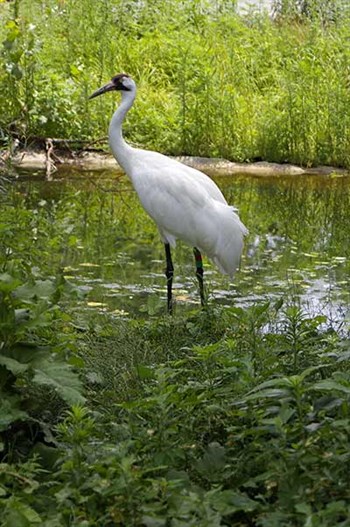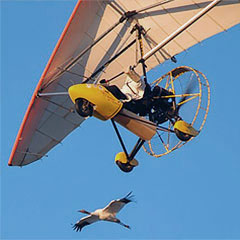Whooping crane on exhibit at Stone Zoo
Tuesday July 29, 2014
 Visitors to Stone Zoo will notice a new feathered face with the addition of a whooping crane. Since making his exhibit debut earlier this month, the male crane has been settling in to his new surroundings.
Visitors to Stone Zoo will notice a new feathered face with the addition of a whooping crane. Since making his exhibit debut earlier this month, the male crane has been settling in to his new surroundings.
Whooping cranes are a critically endangered species, and one of only two crane species found in North America. In the 1940s, these cranes numbered only 21 individuals in the wild. Today, there are around 599 birds, of which more than 300 live in the wild.
The male whooping crane that now resides at Stone Zoo was removed from the wild in late May to ensure his safety. This particular male, the oldest in the eastern migratory population, had set up a territory on an air field at the Volk Field National Guard Base in Wisconsin. He and his mate remained in the area on and around the base because a neighbor had been feeding them.
Despite repeated efforts to encourage him to move elsewhere, the decision was made to remove him from the wild for his safety and for human safety as planes take off and land in the area. Though Stone Zoo was able to provide a home for him, this bird's story serves as an important reminder as to why wildlife should not be fed or disturbed.
“Tremendous efforts have been made to ensure the survival of whooping cranes, and the conservation efforts that have been made on behalf of this species are a great success story,” said Frederick Beall, Zoo New England General Curator. “Although it was determined that the male whooping crane could no longer live safely in the wild, he will be an incredible ambassador for his species at Stone Zoo where visitors of all ages can learn more about this magnificent bird’s personal history and of his wild relatives.”
Migrating whooping cranes fly like a glider, on fixed wings. The birds spiral up, glide down, and begin spiraling upward again. This method of flying is energy-efficient and enables whooping cranes to fly nonstop for great distances. In flight, these birds are distinguished from other large white birds by their long necks extended forward and their legs that trail straight behind.
 The whooping crane at Stone Zoo was one of the first whooping cranes in 2001 to be led on a second migration route by an ultralight aircraft through Operation Migration. In 1999, the Whooping Crane Eastern Partnership (WCEP), which includes Operation Migration, was formed as a consortium of nine federal, state and private agencies (U.S. Fish and Wildlife Service, International Crane Foundation, Operation Migration, Wisconsin Department of Natural Resources, U.S. Geological Survey (USGS) Patuxent Wildlife Research Center, USGS National Wildlife Health Center, International Whooping Crane Recovery Team, National Fish and Wildlife Foundation and the Natural Resources Foundation of Wisconsin), with the common goal of saving and protecting whooping cranes. Through Operation Migration, pilots of ultralight aircraft lead whooping cranes along migration routes in the hopes that the birds will establish summer and winter grounds, and eventually make the journey on their own.
The whooping crane at Stone Zoo was one of the first whooping cranes in 2001 to be led on a second migration route by an ultralight aircraft through Operation Migration. In 1999, the Whooping Crane Eastern Partnership (WCEP), which includes Operation Migration, was formed as a consortium of nine federal, state and private agencies (U.S. Fish and Wildlife Service, International Crane Foundation, Operation Migration, Wisconsin Department of Natural Resources, U.S. Geological Survey (USGS) Patuxent Wildlife Research Center, USGS National Wildlife Health Center, International Whooping Crane Recovery Team, National Fish and Wildlife Foundation and the Natural Resources Foundation of Wisconsin), with the common goal of saving and protecting whooping cranes. Through Operation Migration, pilots of ultralight aircraft lead whooping cranes along migration routes in the hopes that the birds will establish summer and winter grounds, and eventually make the journey on their own.
Whooping cranes, the tallest of the North American bird species, face a variety of threats in the wild including loss of critical wetland space, illegal or accidental hunting, power line collisions, predation and disturbance at nest sites.
Whooping cranes are noted for their stark white feathers and black primary (flight) feathers, which are only visible during flight or courtship dancing. They have a small black patch of feathers below their crimson crown. These birds take their name from their distinctive whooping call, which can carry over several kilometers as a way to advertise their breeding territory to other whooping cranes.
Two distinct migratory populations spend the summer in northwestern Canada and central Wisconsin, and the winter along the gulf coast of Texas and the southeastern United States. Small, non-migratory populations live in central Florida and coastal Louisiana.
At Stone Zoo, the male whooping crane resides in the Alfred Huang North American crane exhibit, an area of the zoo that is also home to sandhill cranes and American alligators.
Photo credits:
Whooping crane: Zoo New England/Dayle Sullivan-Taylor
Ultralight and crane: Operation Migration

